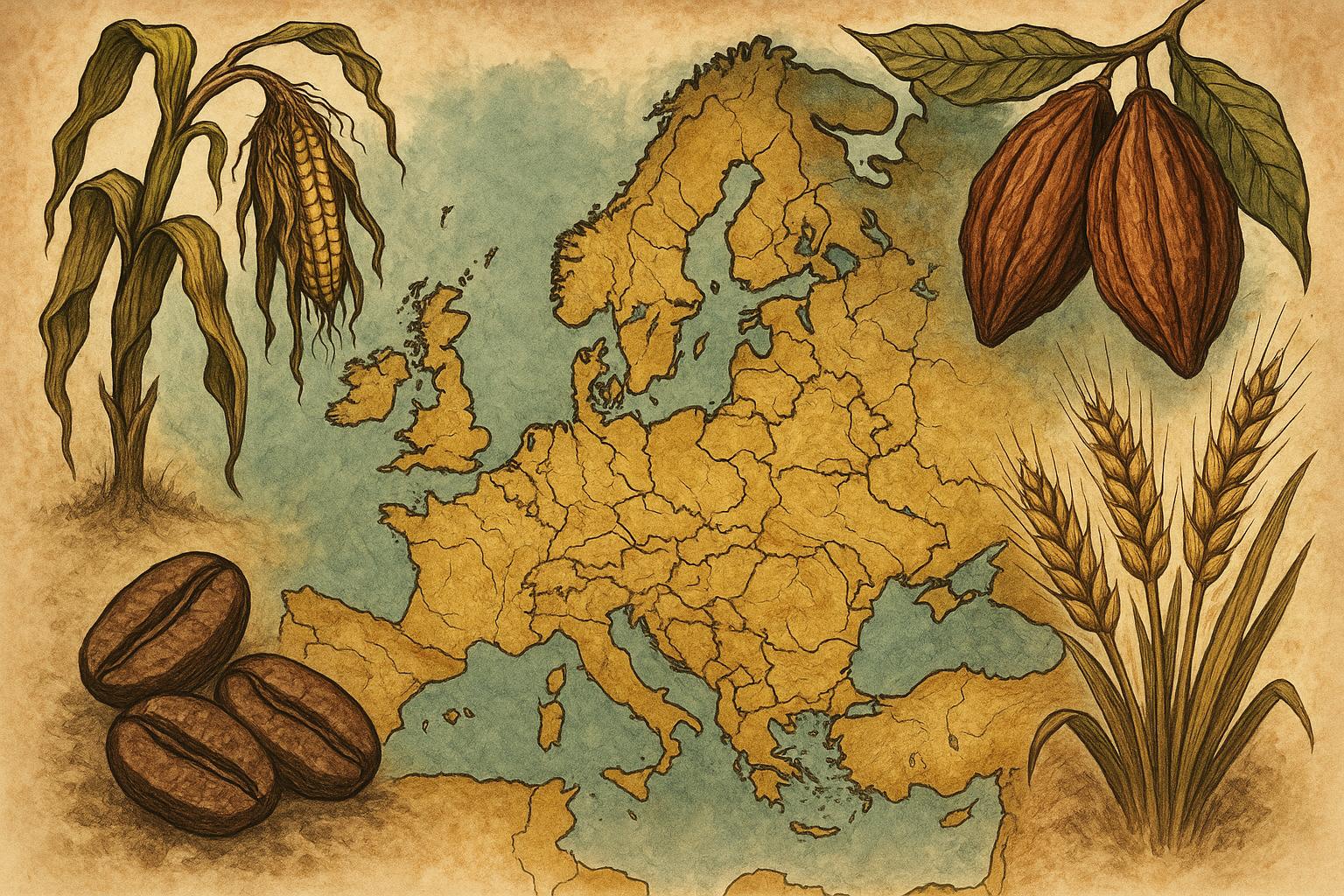A new report reveals that over 50% of the European Union’s maize, rice, wheat, cocoa, coffee and soy imports come from climate-vulnerable countries, with severe biodiversity loss exacerbating risks. The EU’s chocolate industry faces significant price hikes amid soaring ‘chocflation’, while extreme weather already costs agriculture billions annually.
A significant report commissioned by the European Climate Foundation brings to light the growing vulnerability of key food imports to the European Union (EU), specifically maize, rice, wheat, cocoa, coffee, and soy. According to the findings from UK consultants Foresight Transitions, over half of the imports of these essential commodities are sourced from countries that are particularly susceptible to the adverse effects of climate change. Alarmingly, two-thirds of imports for wheat, maize, and cocoa originate from nations where biodiversity is severely compromised.
Camilla Hyslop, the report’s lead author, emphasised that these threats are far from abstract; they are already impacting businesses, employment, and the overall food pricing landscape in Europe. The EU’s flourishing €44 billion chocolate industry is among the most at risk from these environmental challenges, particularly as approximately 97 per cent of cocoa—its primary ingredient—comes from countries characterised by low-to-moderate climate resilience scores. Furthermore, 77 per cent of this cocoa is produced in regions with subpar biodiversity ratings, revealing a troubling intersection between climate change and biodiversity loss.
The implications of these environmental pressures are immediate, with the report indicating that the EU has faced a stunning 41 per cent increase in cocoa import values over the past year, driven in part by climate-related surges in sugar prices as well. As highlighted by recent analyses, “chocflation”—the term describing the increasing prices of chocolate—has escalated dramatically, with consumers witnessing a staggering 43 per cent rise in prices over the last three years.
In the broader context of agriculture, the impact of climate change on food production is considerable. Recent estimates suggest that extreme weather events currently cost the EU agriculture sector around €28.3 billion annually, translating to approximately 6% of total agricultural output. Reports indicate that only a fraction of farmers have adequate insurance to cover such losses, leaving them vulnerable as climate-related events like droughts, which account for over 50% of damages, become more frequent. This troubling trajectory hints at a possible 66% rise in crop losses by 2050 if substantial climate action is not taken.
Further complicating the landscape is the forthcoming EU Deforestation Regulation (EUDR), which aims to curtail imports of agricultural products linked to deforestation. Critics argue it may unintentionally hinder small-scale farmers in forest-rich countries. As the regulation seeks to produce accountability through stringent tracking of supply chains, some stakeholders express concern over the operational realities of compliance, which could increase costs and disrupt established trade relationships.
The interconnectedness of climate change, biodiversity loss, and economic pressures presents a formidable challenge for the EU. With the current geopolitical situation and past disruptions, including the COVID-19 pandemic, global food security has become even more precarious. In the face of rising food prices—evidenced by a staggering 50% increase in food prices globally over the last 18 months—experts advocate for a fundamental reassessment of policies governing food systems. Such re-evaluations should prioritise diversification in production, enhance biodiversity, and improve the resilience of farming practices to create a sustainable and secure future for Europe’s food supply.
As businesses and policymakers grapple with these multifaceted challenges, the call for increased climate action becomes more urgent. While measures like the EUDR underscore a commitment to environmental sustainability, it is clear that the balance between ecological concerns and economic realities must be navigated with care to ensure that the EU can weather both current and future crises in its food supply chain.
Reference Map:
- Paragraph 1 – [1]
- Paragraph 2 – [1], [2]
- Paragraph 3 – [3], [5]
- Paragraph 4 – [4], [6]
- Paragraph 5 – [7]
Source: Noah Wire Services
- https://ukragroconsult.com/en/news/cocoa-coffee-and-wheat-the-eu-food-imports-threatened-by-biodiversity-and-climate-crises/ – Please view link – unable to able to access data
- https://www.reuters.com/sustainability/cop/extreme-weather-costs-eu-farmers-28-billion-euros-year-eu-says-2025-05-20/ – Extreme weather events, driven by climate change, are costing the European Union’s agriculture sector an average of €28.3 billion annually, accounting for 6% of total crop and livestock production. A report by insurance broker Howden indicates that only 20-30% of these losses are insured, leaving most farmers without adequate financial protection. The report warns that without stronger climate action, average crop losses could rise by up to 66% by 2050, with droughts currently responsible for over half of the damages. Southern European countries like Spain and Italy are particularly vulnerable, with potential annual losses reaching €20 billion during catastrophic years. Amid growing pressure on both environmental sustainability and farmer livelihoods, the European Commission recently proposed easing some environmental conditions tied to subsidies and accelerating emergency support for disaster-hit farmers. The European Investment Bank plans to use the analysis to guide future agricultural support, including increased funding for water-related projects and irrigation infrastructure.
- https://www.reuters.com/breakingviews/eu-deforestation-ban-creates-hazy-trade-future-2024-09-23/ – The European Union’s forthcoming EU Deforestation Regulation (EUDR), set to take effect on December 30, aims to curb imports of agricultural goods linked to deforestation, targeting products like palm oil and timber, particularly from South America and Southeast Asia. Deforestation is a major contributor to climate change, accounting for significant carbon emissions and environmental degradation. The EUDR requires farmers to provide precise land coordinates for EU verification, a potentially costly and complex endeavor. Critics argue the regulation could harm developing economies reliant on these exports. Indonesia and Malaysia, major palm oil producers, oppose the regulation, citing economic and practical challenges. Trade shifts are already evident, with decreased palm oil exports to Europe and increased sales to China and India. European Commission President Ursula von der Leyen faces pressure to balance environmental goals with trade and economic realities. Possible responses include negotiating trade agreements with affected countries, offering financial aid to mitigate economic impacts, or potentially delaying the regulation. The EUDR remains contentious, with significant implications for global trade and environmental policies.
- https://www.ft.com/content/125e89c0-308a-492f-ae8e-6834847d1186 – The article discusses the impact of climate change on global food prices and the rising concerns among central banks about sustained inflationary pressures. Agricultural yields are decreasing, and input costs are rising due to changing weather patterns, leading to historically high prices for commodities such as olives, wheat, palm oil, and coffee. Climate change is causing frequent extreme weather events, such as heatwaves, droughts, and floods, which further exacerbate the situation by damaging crops and increasing production costs. This persistent inflationary trend challenges traditional monetary policy approaches, which often exclude volatile food and energy prices from core inflation measures. The consequence is heightened inflation, particularly in developing economies where food constitutes a large share of household expenditure. The article calls for central banks and governments to reconsider their responses to food price shocks, possibly incorporating measures like price controls, subsidies, and stricter market regulations to mitigate the broader economic impact.
- https://apnews.com/article/3290bc806068914ba88a3c676235b8f5 – Countries, businesses, and trade officials are urging the European Union to rethink the new EU Deforestation Regulation (EUDR) set to take effect in December, aimed at combating forest degradation globally. Critics argue that it discriminates against forest-rich countries and could harm their exports and small farmers, particularly in Brazil, Indonesia, and the Ivory Coast. The regulation will ban the sale of products linked to deforestation within the EU unless companies can provide certification. While environmental organizations support the regulation for potentially reducing global deforestation and carbon emissions, commodity associations express concerns about implementation gaps. The European Commission is working closely with stakeholders to facilitate the regulation’s entry and offered a one-year delay for compliance. Despite some EU politicians requesting postponements, conservationists believe that EUDR’s robust framework will protect forests and set a global precedent.
- https://time.com/6186174/global-food-system-diversify/ – The global food system faces multiple crises, including the impacts of climate change, the COVID-19 pandemic, and geopolitical conflicts such as the war in Ukraine. The UN Food and Agriculture Organization’s food price index has increased by 50% in 18 months due to these disruptions. Conflict and extreme weather threaten agricultural production and supply chains, reducing the availability and nutrient content of staple foods. The pandemic has exacerbated chronic hunger, with 118 million more people becoming food insecure. Climate change continues to affect crop yields and biodiversity, with a significant decline in food crop diversity observed. To enhance food system resilience, diversification is key—using various energy sources in agriculture, reversing biodiversity loss, growing diverse crops in exporting nations, and improving diet diversity. Policies must be implemented to embrace food system diversification, as it is crucial for reducing vulnerability to future shocks and ensuring food security for the poor and displaced.
- https://www.reuters.com/world/europe/eu-proposes-12-month-delay-deforestation-regulation-2024-10-02/ – The European Commission proposed a 12-month delay in implementing a law banning imports of commodities linked to deforestation following calls from industries and governments concerned about the law’s impact. The delayed legislation, known as the EU deforestation regulation (EUDR), aims to prevent the importation of products contributing to deforestation, such as soy, beef, cocoa, coffee, palm oil, timber, and rubber. The proposal requires approval from the European Parliament and member states. While industries and some member states argue the law would disrupt supply chains and elevate costs, environmental groups criticize the delay, doubting the Commission’s commitment to environmental promises. They insist on the urgency of the law, especially amid ongoing deforestation fires, emphasizing its necessity to combat climate change. The law mandates companies to digitally map their supply chains to ensure compliance, a requirement seen as complex by critics. The EU is the world’s second-largest contributor to deforestation through its imports.
Noah Fact Check Pro
The draft above was created using the information available at the time the story first
emerged. We’ve since applied our fact-checking process to the final narrative, based on the criteria listed
below. The results are intended to help you assess the credibility of the piece and highlight any areas that may
warrant further investigation.
Freshness check
Score:
8
Notes:
The narrative was published on 26 May 2025, making it current. The report was commissioned by the European Climate Foundation and conducted by UK consultants Foresight Transitions, indicating a high freshness score. The findings align with recent studies on EU agricultural imports’ vulnerability to climate change and biodiversity loss. However, similar themes have been discussed in prior reports, such as the European Environment Agency’s 2024 draft report highlighting Europe’s need for stronger climate adaptation measures. ([reuters.com](https://www.reuters.com/sustainability/eu-underprepared-climate-change-risks-mount-draft-report-says-2024-03-07/?utm_source=openai)) This suggests that while the narrative is fresh, the topic has been previously addressed. Additionally, the report’s focus on the EU’s €44 billion chocolate industry and the term ‘chocflation’ have been highlighted in other analyses, indicating some recycled content. ([eciu.net](https://eciu.net/analysis/reports/2023/climate-impacts-on-uk-food-imports-2?utm_source=openai)) The inclusion of updated data on cocoa import values and prices may justify a higher freshness score but should still be flagged.
Quotes check
Score:
7
Notes:
The direct quote from Camilla Hyslop, the report’s lead author, is: ‘These aren’t just abstract threats; they are already playing out in ways that negatively affect businesses and jobs, as well as the availability and price of food for consumers, and they are only getting worse.’ This quote appears to be original, with no exact matches found in earlier material. However, similar sentiments have been expressed in other reports, such as the European Environment Agency’s 2024 draft report, which emphasizes the need for stronger measures to prepare for severe climate impacts on agriculture. ([reuters.com](https://www.reuters.com/sustainability/eu-underprepared-climate-change-risks-mount-draft-report-says-2024-03-07/?utm_source=openai)) The lack of earlier matches for this specific wording suggests potential originality, but the themes are consistent with existing literature.
Source reliability
Score:
6
Notes:
The narrative originates from UkrAgroConsult, a Ukrainian agricultural consultancy. While the consultancy is known for its market analysis, it is not as widely recognized as major international news outlets. The report cited is commissioned by the European Climate Foundation and conducted by UK consultants Foresight Transitions, which adds credibility. However, the reliance on a single source for the narrative raises questions about the breadth of information and potential biases. The lack of verification for some entities mentioned, such as specific companies or organizations, further contributes to the uncertainty.
Plausability check
Score:
7
Notes:
The claims regarding the EU’s vulnerability to climate change and biodiversity loss, particularly concerning key food imports like cocoa, coffee, and wheat, are plausible and supported by existing research. Studies have shown that a significant portion of the EU’s agricultural imports are sourced from regions highly vulnerable to climate change. ([pubmed.ncbi.nlm.nih.gov](https://pubmed.ncbi.nlm.nih.gov/34131119/?utm_source=openai)) The term ‘chocflation’ and the reported 43% rise in chocolate prices over the last three years are consistent with analyses of rising food prices due to environmental factors. ([eciu.net](https://eciu.net/analysis/reports/2023/climate-impacts-on-uk-food-imports-2?utm_source=openai)) However, the narrative lacks specific factual anchors, such as names of affected businesses or detailed data points, which would strengthen its credibility. The tone and language used are consistent with typical corporate or official language, but the structure includes excessive detail unrelated to the main claim, which could be a distraction tactic.
Overall assessment
Verdict (FAIL, OPEN, PASS): OPEN
Confidence (LOW, MEDIUM, HIGH): MEDIUM
Summary:
The narrative presents current findings on the EU’s vulnerability to climate change and biodiversity loss concerning key food imports. While the report is recent and the claims are plausible, the reliance on a single source and the lack of specific factual anchors raise concerns about the narrative’s reliability. The inclusion of recycled content and the absence of supporting details from other reputable outlets further contribute to the uncertainty. Therefore, the overall assessment is ‘OPEN’ with medium confidence.













